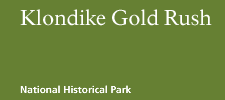|
How do I plan my time in Skagway?
This website has lots of information to help you plan your trip to the park. Click on the links to the left and explore the site. Please click on the Chilkoot Trail link on the home page for information about permits, reservations and more details about a hike on the trail. In a hurry? Check these questions to see if your answer is here.
What, exactly, is the park?
Klondike Gold Rush National Historical Park consists of three units. The Skagway unit consists of several buildings in the historic district in the town of Skagway, Alaska. The White Pass unit is the historic trail that led from Skagway up the Skagway River valley to White Pass and on to Bennett, British Columbia. That unit is most easily seen from the White Pass and Yukon Route Railway or from the Klondike Highway. The third unit of the park is the famous Chilkoot Trail and Dyea. They are located one valley north of Skagway. Dyea was the town that rivaled Skagway during the gold rush.
Is there camping in the park?
The park has a campground at Dyea. It is operated by the National Park Service and is available on a first-come, first-served basis. It seldom fills except on Canadian holidays when our friends from just over the border come down for a visit. The campground has no facilities other than vault toilets. Bring your own water and firewood. There are no groceries available at Dyea so bring your own grub as well. The $6.00/night fee at the campground helps us maintain the minimal facilities.
Isn’t there a park like this in Seattle?
Yes! The Seattle park is also called Klondike Gold Rush National Historical Park and consists of a visitor center with exhibits that tell the story of the Klondike gold rush from the Seattle end of things. Seattle was a major staging and supply point for the gold rush. The Seattle park, as well as many sites in Canada and Alaska are all part of the Klondike Gold Rush International Historical Park.
| 





